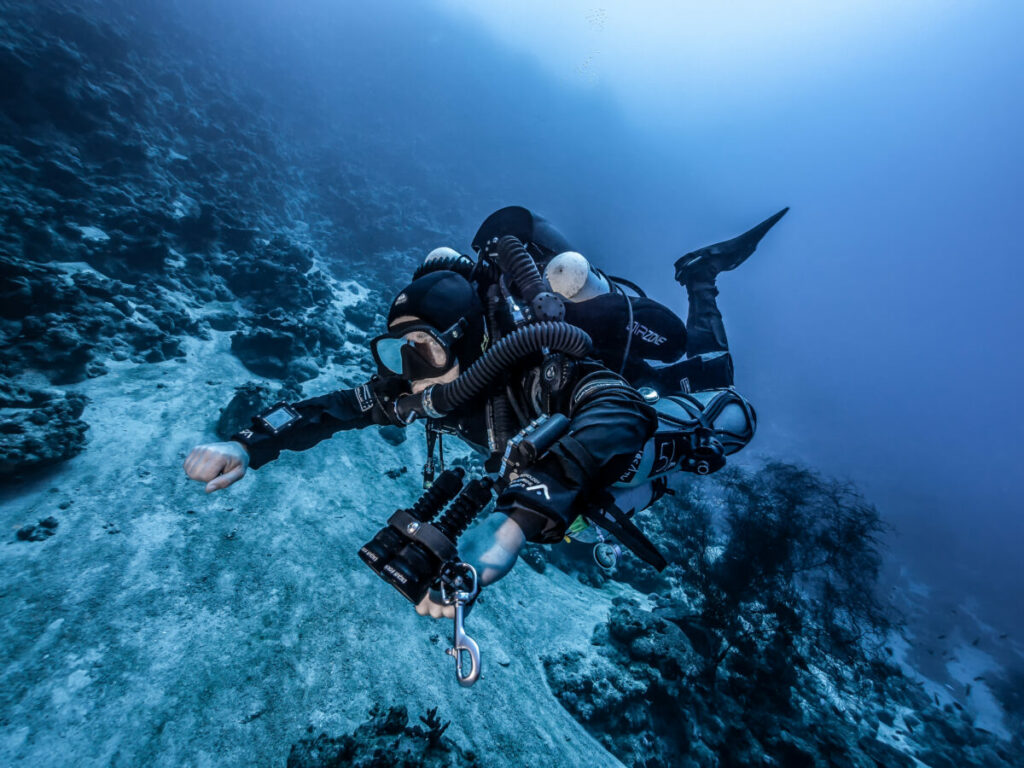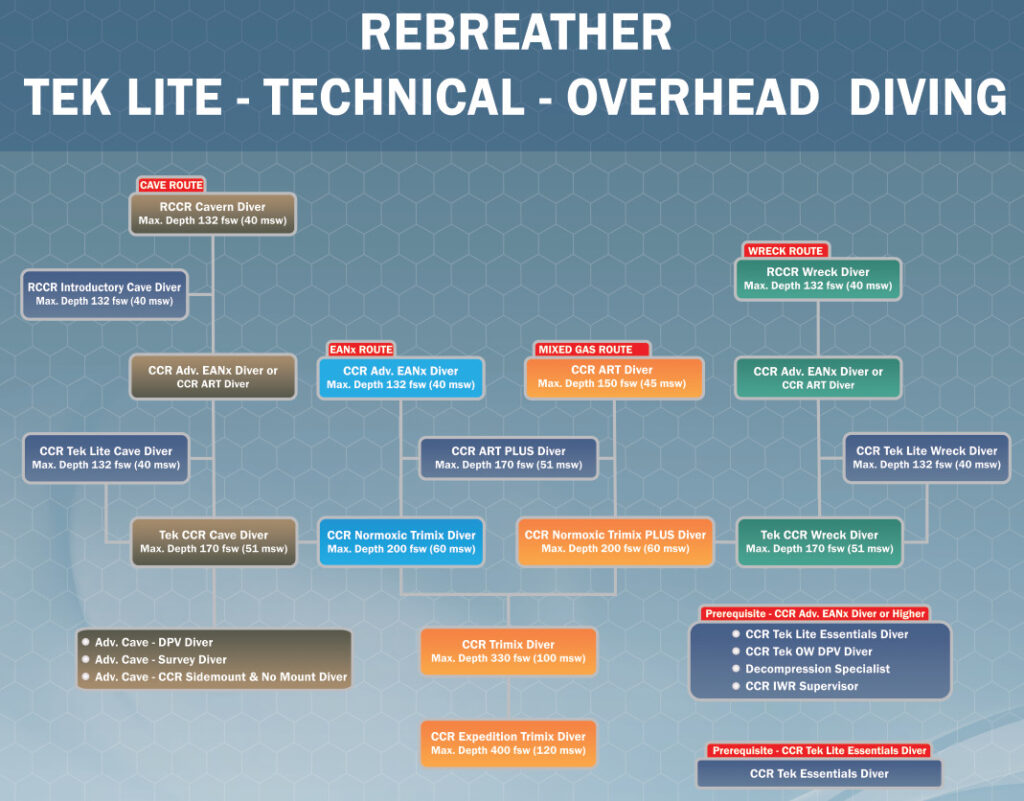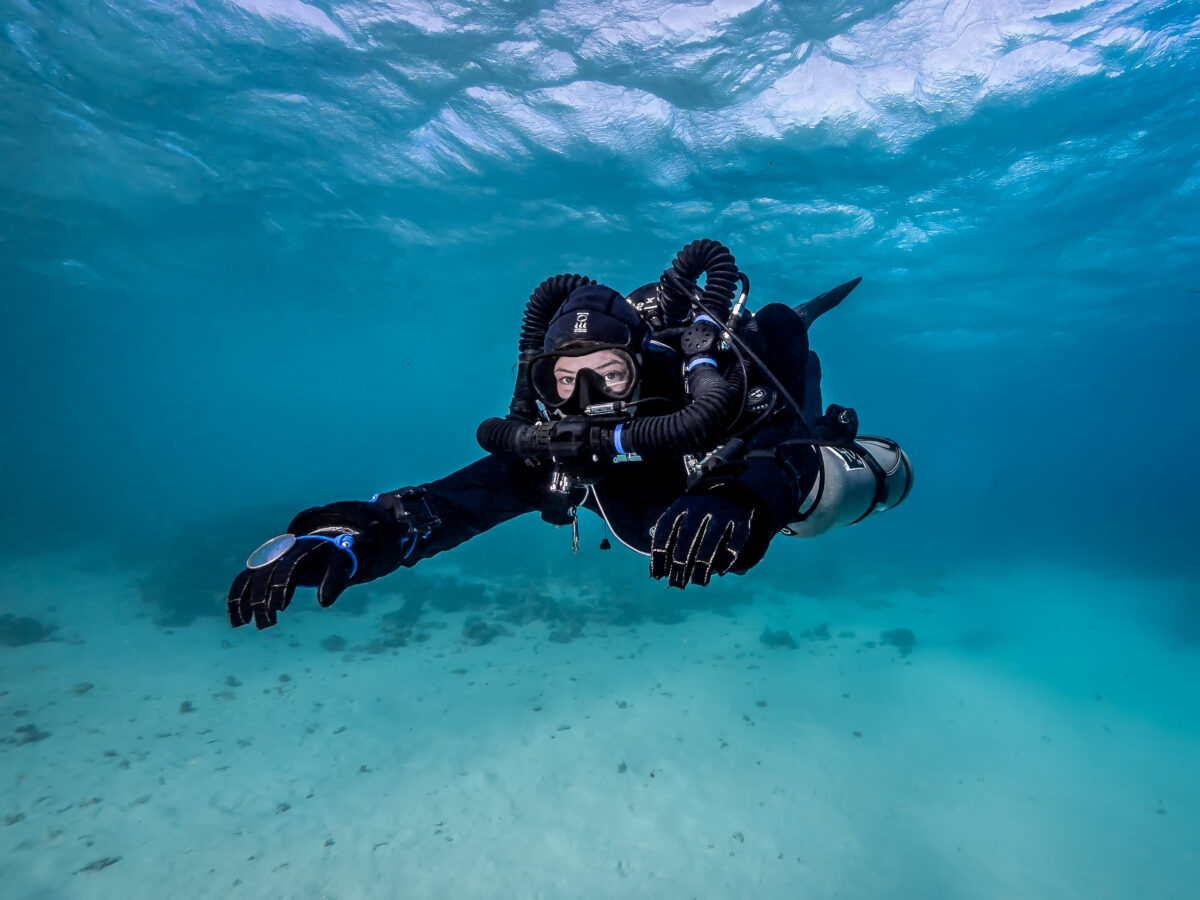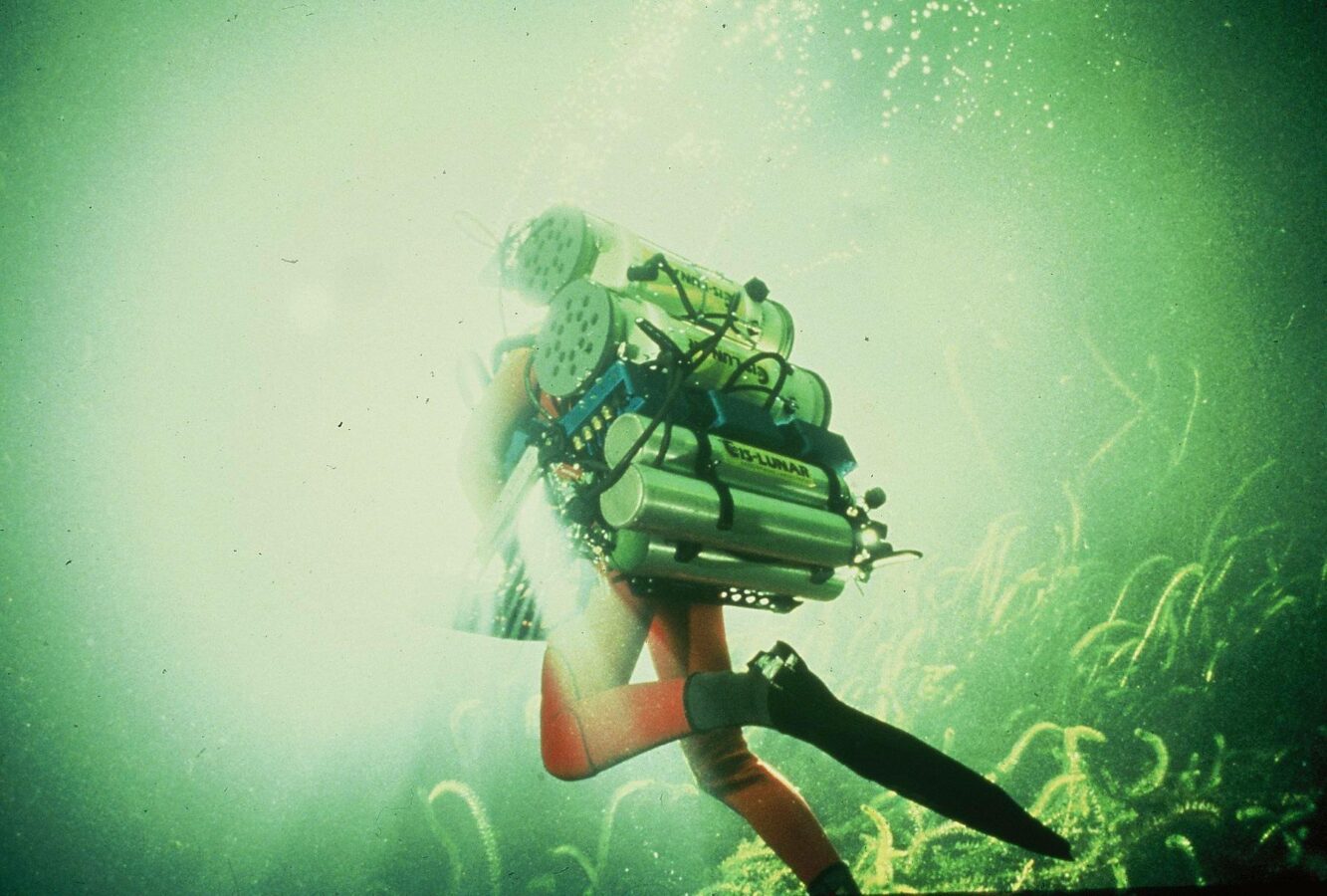What is the Advantage of a Rebreather?
Interested in Rebreather diving?!
Have you already heard about Rebreather diving but the whole thing is just a vague concept for you?
Then keep on reading or jump directly to the IANTD course structure if you are thinking about taking the next step in your diving career and start Rebreather diving!
HOW DOES A REBREATHER WORK?
With OC (Open Circuit) diving equipment the diver only uses a fraction of the oxygen supplied by the tanks. With each exhalation the diver releases unused oxygen into the ambient atmosphere and it’s gone forever.
The basic working principle of a Closed Circuit Rebreather consists of recycling the breathing mixture within a loop. To keep a constant ppO2, small amounts of oxygen are injected (either manually or automatically) into the exhaled gas to replace the oxygen which has been metabolised by the diver. Carbon dioxide produced by the diver gets absorbed by the Scrubber (absorbent). The composition of the breathing mixture changes continuously during the dive.
BENEFITS OF A CLOSED CIRCUIT REBREATHER
- Gas efficiency: As each breath you exhale gets recycled and enriched with oxygen so you can breathe it again, the amount of gas you actually have to carry with you is drastically reduced. This comes in handy on trimix dives as helium tends to get more and more expensive. Keep in mind though that you should always carry adequate bailout with you on all dives to make it safely up to the surface in a worst-case scenario.
- Reduced Decompression – extended no decompression times: On a Rebreather you are diving following a fixed partial pressure of O2 which means its fraction is changing with depth (exactly the opposite compared to OC dives). Therefore, you always are exposed to the lowest concentration of inert gas possible, regardless of depth, which leads to longer no decompression times and more efficient decompression profiles.
- Warm gas: gas passing to a little opening in the first stage is expanding and cooling down till it reaches the OC diver. A Closed Circuit Rebreather diver is breathing the same gas again and again and only little by little other gas is added which results in a more warm and moist gas so mostly you do not get as easily cold on a CCR.
- Bubbleless silence! You will produce bubbles due to the expanding gas on ascents but in between you will have these moments of absolute silence seeming that the laws of physics are not applying to you! This is especially a huge advantage if you are into observing aquatic life!

DRAWBACKS OF A CLOSED CIRCUIT REBREAHTER
- Costs: The units itself are still quite cost intensive and you should not forget about otherexpenses like annual services and replacement of the oxygen cells plus Sorb, Helium and especially training. They really start to pay back though on longer and deeper dives where you either couldn’t do them anymore on OC or you would waste a lot of helium.
- Complex: although the working principle of a Closed Circuit Rebreather is quite simple – CO2 out, O2 in – don’t forget that we mess around with one of the most important things for us: the gas we breathe! With a higher level of complexity, it is also important to gain and maintain good working principles with the unit (pre-dive preparation and maintenance) and by training essential skills.
- No more controlling your buoyancy by breath: for most OC divers its already so second to nature that they don’t even realise how much they depend on it until they do their first dive on a rebreather. Your breathing pattern has no overall influence on your buoyancy as you only move gas from your lungs to the counterlungs forwards and backwards, but the volume actually never leaves contact with your body.
- Travelling: travelling with a Rebreather means an extra bag which you have to take into account when your planning your trip. Not all dive centers are rebreather friendly dive centers so you better check if there is Sorb available and if they have or at least can fill your CCR tanks. Do you can get spare parts or is it maybe better to bring your own spare kit?
- Risk: With more complex machines also, more risks arise in the picture which we don’t even know from OC diving. Closed Circuit Rebreather diving is a commitment and a high level of self-discipline is a must! If you are not willing to learn and train you will bring yourself and buddy sooner or later into big troubles!
Lagona Divers – Technical CAN OFFER TRAINING ON Three DIFFERENT UNITS:
X-CCR FROM IQSUB
X-CCR powered by Shearwater is an expedition grade rebreather developed using years of experience with CCRs with respect to the needs of divers and explorers. The X-CCR has a compact and ergonomically designed hardware and facilitates easy tool-less assembly and maintenance
- Durable and user-friendly design
- Variable device connections
- Expandable & upgradable
- Variable configuration
- Integrated HP & CO2 sensors
- Reliable & simple
Triton CCR FROM M3S
The Triton CCR is a manual chest-mounted CCR. This feature gives it great adaptability. This means that the unit can be dived in a standard sidemount configuration, a twinset or a single cylinder configuration (backplate). As it is an mCCR unit, 0.07 l/min of oxygen is supplied to the circuit through a constant mass flow orifice. Since this amount is about the normal amount metabolised by a person at medium workload, the diver should not have to manually feed O2 into the circuit. In short, the advantages lie in simplicity. An mCCR does have electronics to monitor the PO2 of the breathing circuit, but these are very simple. Unlike an eCCR, there are no electronics or cables connected to batteries or electronic solenoids in the breathing circuit. This means fewer sources of error.
- 7 kg ready to travel
- 12.2 kg ready to dive
- The TRITON is the first and only mechanically controlled closed circuit rebreather to be approved in accordance with the CE EN 14143:2013, 0-100m.
- The TRITON is the CE approved rebreather with the best work of breathing (wob) 1.57 j/L at 100 m at 75 L/min with HELIOX 10/90 diluent.
PRISM2 FROM HOLLIS


The PRISM 2 is a digitally controlled electronic closed circuit rebreather with split Front-Mounted Counterlungs (FMCL) or Back-Mounted Counterlungs (BMCL). It incorporates a radial design scrubber for the best possible duration and work-of-breathing. All gas delivery systems on the PRISM 2 have both automatic and manual function. The Prism2 uses the Shearwater electronics.

CCR DIVING TRAINING VIA IANTD
Lagona Divers – Technical offers CCR training via IANTD. Your adventure starts with what commonly speaking is known as the

“MOD 1”
CCR ADVANCED EANX DIVER
The course consists of min. one confined water session and six open water dives with a total of 500 minutes in water training using the specific Rebreather on which they are being trained.
Purpose:
This Program is designed to train competent divers in the safer use and technology of CCR for dives requiring decompression.
It is also especially useful to train divers who wish to dive up to 40msw as part of the Advanced EANx course if using air as diluent.
Prerequisites:
1. Certifications requirements:
- Must be qualified in IANTD EANx Diver or equivalent.
- Must be qualified in IANTD Deep Diver or RCCR Deep Diver or equivalent.
2. Age requirement:
- Must be a minimum of 18 years of age.
3. Dive experience: Proof of a minimum of 50 logged dives
CCR ADVANCED RECREATIONAL TRIMIX DIVER AND CCR ART PLUS
The course consists of min. one confined water session and six open water dives with a total of 500 minutes in water training using the specific Rebreather on which they are being trained.
Purpose:
This Program is designed to train competent divers in the safer use and technology of CCR for dives requiring decompression.
It is also especially useful to train divers who wish to dive up to 45 msw as part of the Advanced
Recreational Trimix course in which case the END will not exceed 30 msw when using Trimix as diluent
Prerequisites:
1. Certifications requirements:
- Must be qualified in IANTD EANx Diver or equivalent.
- Must be qualified in IANTD Deep Diver or RCCR Deep Diver or equivalent.
2. Age requirement:
- Must be a minimum of 18 years of age.
3. Dive experience:
- Proof of a minimum of 50 logged dives.
“MOD2“
CCR NORMOXIC TRIMIX DIVER AND CCR NORMOXIC TRIMIX PLUS DIVER
The course consists of min. one confined water session and five open water dives with a total of 360 minutes in water training using Air, EANx or Trimix.
Purpose:
This Program is designed to train divers in the safer use of Rebreathers for dives using normoxic helium-based gas mixtures.
The knowledge and skills taught in this program are designed to qualify divers to perform Normoxic Trimix Dives up to 60 msw or Normoxic Trimix Plus dives up to 70 msw.
Prerequisites:
1. Certifications requirements:
- must be qualified in IANTD Advanced EANx or equivalent
2. Age requirement:
- Must be a minimum 18 years of age.
3. Dive experience:
- Must provide proof of a minimum of 100 logged dives of which at least 25 rebreather dives and 50 hours on the unit with at least 50% of them logged on the same CCR to be used in the course.
- At least 30 dives were deeper than 27 msw.
EXTRA LIMITS FOR REBREATHER NORMOXIC TRIMIX PLUS:
1. For Rebreather Normoxic Trimix Plus Diver Program, no dives may be conducted to depths greater 70 msw.
“MOD 3”
CCR TRIMIX DIVER
The course consists of min. one confined water session and five open water dives with a total of 360 minutes in water training using air, EANx, Trimix or Heliox provided the depths are acceptable for the gas used.
Purpose:
1. This Program is designed for those individuals already involved in deep diving activities but is not intended to be used as an enticement to divers who are content to remain in Sport or EANx diving limits.
2. Trimix affords a safer means for deep water exploration for divers who dive deep or perform with a clear head at depth. The IANTD Trimix Diver Program requires the diver to be self-sufficient/reliant.
The knowledge and skills taught in this program are more than adequate to qualify divers to perform Trimix Dives outside of training up to 100 msw.
Prerequisites:
1. Certifications requirements:
- Must be qualified as an IANTD Normoxic Rebreather Diver or equivalent.
- Must be taking the Normoxic Rebreather Diver and Rebreather Trimix Diver course on an approved Rebreather for mixed gas diving, with all dives other than confined water made on Trimix or Heliox.
2. Age requirement:
- Must be minimum 18 years of age.
3. Dive experience:
- Must provide proof of a minimum of 200 logged dives with at least 100 hours on the rebreather to be used.
- At least 25 dives were to depths between 40 msw and 60 msw.
- If already certified as Rebreather Normoxic Trimix Diver on another recognized unit by IANTD, 25 rebreather dives and 50 hours must be on the unit specific for the class.
If you have more questions or you would like to give CCR diving a try feel free to Contact us!



